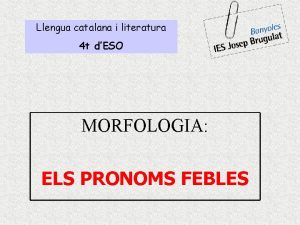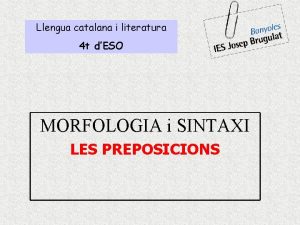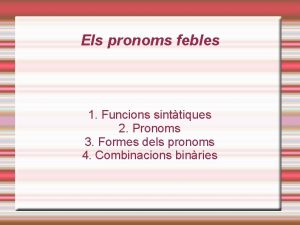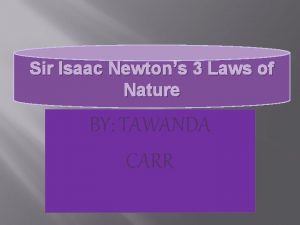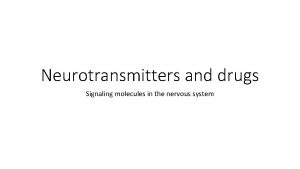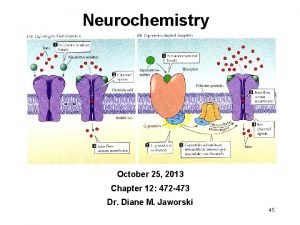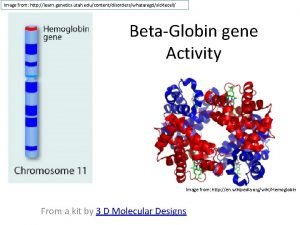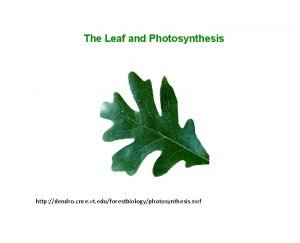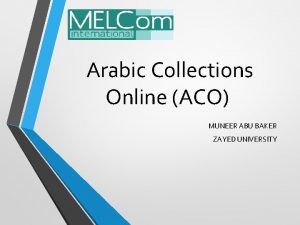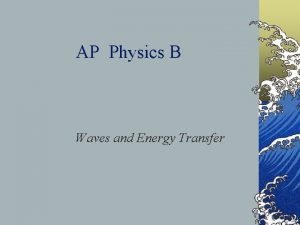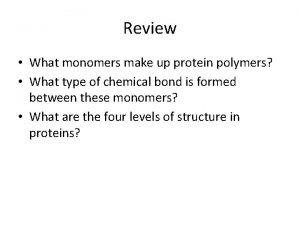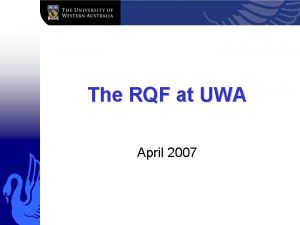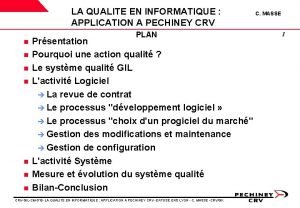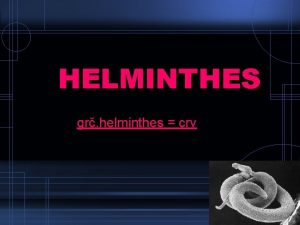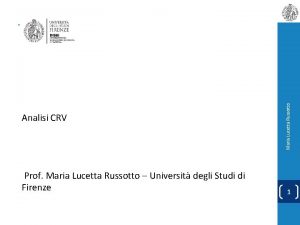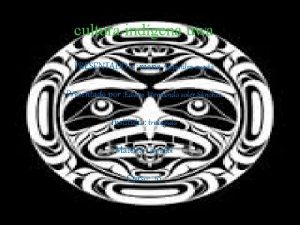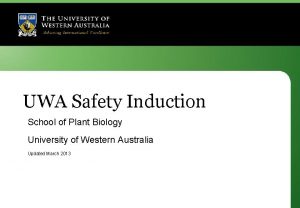http www crv uwa edu aupresentationsPamvotis European class







































- Slides: 39

http: //www. crv. uwa. edu. au/presentations/Pamvotis European class 2000

Lake Pamvotis Surface: 24, 1 km 2 Depth: max. 9, 2 m mean 4, 3 m Length: 7 km Max width: 3 km http: //www. duth. gr/Epirus/Ioannina/ioan 3. html

Geology The lake Pamvotis is a karstic lake characterized by: • calcarious mountains in the north • the contact with carbon and silicon formations and • recent deposits of the alluvial valley http: //www. cwr. uwa. edu. au/Presentations/Pamvotis/

Surrounding of the lake • The city of Ionnina with 100. 000 inhabitants is set at the border of the lake Pamvotis. • Further several agricultural activities take place close to the lake: • Livestock breeding • Farming • cultivation • The lake itself is used for fishery, tourism, irrigation, sport ect. Domestic, argicultural and industrial effluents enter the lake through several canals

Physicochemical parameters • Temperature: 25, 1° C • p. H: 7, 49 • TDS: 140 mg/l • Conductivity: 281 μSiemens • Disolved Oxygen: 9, 8 mg/l • Transparency: 72 cm (Secchi)

General view of the lake • On the north part a corridor of vegetation surround the lake. On the over surrounding no barrier can filter agricultural effluents and domestic sewages from the surrounding area. • There is a productive community of aquatic vegetation especially in the north part.

The plants collected in the lake Aquatic vegetation: Typha sp (Typhaceae), Lemna sp. (Lemnaceae), Nymphea alba (Portulacaceae), Iris sp. (Iridaceae), Land vegetation: Salix sp. (Salicaceae), Rapistrum sp. (Brassicaceae), Mentha aquatica (Lamiaceae), Ulmus minor (Ulmaceae), Holcus lanatus (Graminae), Urtica sp. (Urticaceae), Iris sp. (Iridaceae), Capsella bursa-pastoris (Brassicaceae), Geranium columbinum (Geraniaceae), Galium aparyne (Rubiaceae), Rubus canescens (Rosaceae), Epilobium sp. (Onagraceae), Senecio sp. (Compositae) and two species of Bryophyta Our sample does not include all the species that exist around and in the lake (64 species and subspecies have been described by Sarika. Hatzinikolaou M. in 1994). In red are the plant witch characterize the communities.

Arrangement of the communities Reed-bed

Description of the communities Aquatic community: Reed-bed • Characteristic water-fringe vegetation, common in eutrophic lakes, shalow water. • Formation of tall helophytes, usually species poor and often dominates by one species: Typha sp. (Typhaceae often grow in large patches in shallow water and cause to silt up) Reed-beds, usually characterized by Phragmition australis and Scirpion maritimi Over aquatic community with one characteristic species: Lemna sp

the aquatic vegetation Photo: Geraldine Kapfer

Phragmites australis http. //www. euronet. nl/users/mbleeler/folis/bsmain-e. html

Land community: • On the edge of the lake • characterized by Salix alba • Artificial stony substrate built by human that leads to a unnatural type of vegetation • Low vegetation: <30 cm • High diversity: 14 family

Salix alba http. //www. euronet. nl/users/mbleeler/folis/bsmain-e. html

Observations on Phytoplankton of Pamvotis Lake • Phytoplankton consists of microscopic plant organisms adapted to suspension in the water and exposed to passive movement by wind and currents • These organism are unicellular but many of them form colonies and threads ranging in size from <1µm up to >500µm.

EUTROPHICATION Although eutrophication starts with a high input o plant nutrients into a water ecosystem leading to hi primary production, it is not, nevertheless, a simple process but is complex. A large number of factors interact, altering the structure of biotic communities The first change to be seen is the mass developm of blue - green algae in freshwaters. Blue - green algae blooms are the most evident symptom of eutrophication.

Location of the sampling • in the littoral zone-shallow area in Pamvotis Lake with micro- macrophytic vegetation (rich in reeds)

Methods of sampling net Equipment used for sampling • Samples were collected in one station just in one day • The material collected (www. aquaticresearch. with the net was the com/products. htm) fresh material Water sampler • The lake water collected with the Water sampler was fixed with Lugol’s solution (www. idromar. it/watersampler. htm)

Laboratory work Fresh material The fresh material composition was examined under microscope to identify the different algae and which one was in abundance. Lugol’s material The Lugol’s material was used for identification and counting of phytoplankton according to Utermoehl’s sedimentation method. It was put in a sedimentation chamber of 2 ml for three hours, and then examined under the inverted microscope.

Algae in net-samples (fresh material) Class: Bacillariophyceae (diatoms) Genera: Navicula (benthic in the water column), Asterionella (http; /courses. smsn. edu/ rgr 592 f/algae/asteri_a. htm) Navicula (www. vvm. com/ ~jevans/navicu 01. html) Other diatoms observed: : Fragilaria, Synedra, Aulacoseira granulata, Cyclotella

The dominant alga Class: Chlorophyceae Order: Chlorococcales Genera: Pediastrum (www. rrz. uni-hamburg. de/biologie/b_online/d 44/ pediastr. htm) Class: Cyanophyceae Order: Chroococcales Genera: Microcystis (photo M. Moustaka-Gouni)

Algae in the lake water preserved with Lugol Class: Cyanophyceae Order: Chroococcales Genera: Microcystis, Aphanocapsa, Aphanothece (dominant) Class: Cyanophyceae Order: Nostocales Genera: Anabeana (www. biol. tsukuba. ac. jp/ ~inouye/ino/cy/56. gif Class: Bacillariophyceae Genera: Aulacoseira, Cyclotella, Pleurosigma (www. biol. tsukuba. ac. jp/ ~inouye/ino/st/ baci_pen_pic. html) Class: Chlorophyceae Order: Desmidiales Genera: Staurastrum Class: Chlorophyceae Order: Chlorococcales Genera: Scenedesmus (dominant) (www. dipbot. unict. it/sistematica/Scenede. html)

Quantitative analysis • This analysis was made to determine phytoplankton biomass by calculation of the biovolume of each species at the final step. • At least 100 specimens (cells or colonies) of the most importan phytoplancton species should be counted and as a total at least 400 individuals in the sedimentation chamber. • Firstly we counted the total number of individuals in different optical fields (grids) until 400 individuals to be reached. • In order to have the population density of the most abundant algae it is important to know the factor for one grid in the magnification used for counting. This factor is divided by the total number of the grids. Then the result is multiplied with the total number of individuals.

RESULTS In the net sample the most abundant alga was Microcystis, which was not only in colonies but also in separate cells. In Lugol the most abundant algae were Aphanothece and Scenedesmus. Population density: a) Aphanothece sp. 1, 359, 223 cells/ml (most abundant) b) Scenedesmus sp. 180, 844 cells/ml (greater biomass) There were also benthic and epiphytic organisms due to the fact that the station where the sampling took place was shallow and near the shore.

v. The different results between the two methods are due to the fact that the fresh material was collected by a net with pore diameter of 50 μm which means that most of the phytoplanktonic organisms with one cell (or colony) dimension smaller than 50 μm were not collected. v. The high abundance of the cyanophyte Aphanothece and the chlorophyte Scenedesmus are indicative of a highly eutrophic lake but it is not possible to confirm that because the sampling has been done only in one day and in one station (one point in time and space).

LIST OF THE SPECIES OF ZOOPLANKTON IN THE LAKE IOANNINA ROTIFERA ü ü ü ü Asplanchna priodonta Trichocerca pusilla Trichocerca capucina Trichocerca cylindrica Synchaeta Polyarthra Anuraeopsis fissa Ascomorpha spp Trichotria pocillum Lepadella sp. Lecane spp. Brachionus quadridentatus Brachionus forficula Keratella cochlearis +++ ++ + + + ++ CLADOCERA ü ü Bosmina longirostris Chydoridae Chydorus Exoskeleton of Alona spp. ü Alona rectangula ü Daphnia cucullata +++ + ++ COPEPODA ü ü Stage of Nauplius Stage Copepodite Group Cyclopoida Exoskeleton of Harpacticoida +++ ++

The three main groups of zooplankton, Rotifera, Cladocera and Copepoda have been found. The sample is characterized by a satisfactory diversity – 23 taxa, taking into account the unique sampling in only one station. More than half are rotifers. About 1/3 of the taxa mentioned are abundant. It should be noticed that the way of conserving often alterate the morphology of the sample and the species differentiate themselves often very slightly. So, it is difficult to identify the exact species and sometimes it is impossible to go further than the genus.

TROPHIC STATE OF THE LAKE INDICATORS OF EUTROPHIC CONDITIONS q Trichocerca pusilla q Trichocerca cylindrica §According to several reserchers, q Trichocerca capucina almost half of the taxa are indicators of eutrophication. q Polyarthra q Anuraeopsis fissa q Brachionus quadridentatus §The Pamvotis lake seems to be eutrophicated, at least the area q Keratella cochlearis where the sampling took place. q Bosmina longirostris q Alona rectangula q Daphnia cucullata

ZOOPLANKTON OCCURRENCE IN RELATION TO WATER TEMPERATURE • The range of temperature for most of the taxa is between 10 and 25 o. C. • Some of them are eurythermal and accept a wide range of temperature. • Some are warm stenothermal species, such as Trichocerca pusilla, Anuraeopsis fissa. • It is peculiar that two tropical and subtropical species were also found, as Trichocerca cylindrica and Brachionus forficula. The latter is mentioned probably for the first time in Ioannina lake. • B. quadridentatus, a species preferring warm waters was found also for the first time in this lake. • Concluding, the lake is a rather warm one. A reason for this could be the fact that it is a shallow lake. • Because of the recent appearance of some warm – stenothermal species, it is probable that the temperature of the lake is rising.

Distribution: Pelagic or benthic? • Characteristic benthic genera: Brachionus, Trichotria, Lapadella, Lecane. • Characteristic pelagic species: Asplanchna priodonta, Bosmina longirostris, Daphnia cucullata. • Sampling took place near the shore where pelagic and benthic species coexist.

ZOOBENTHOS Sampling The sampling took place 0. 5 m away from the lake’s bank in a depth of 0. 5 m and at a distance of 5 meters. The substrate was consisted of cobbles, macrophytes and reeds. The animals were found attached under the cobbles and were collected by hand. We tried to take sample from the benthos further away from the lake’s bank, in a plava, but it was virtually impossible, because the lake’s bottom may have been covered by beton.

The following table presents the families of animals found:

Percentage of benthic invertebrates

According to the previous tables the Diptera larvae of the family Chironomidae are the most abundant. This is something characteristic for the lake Pamvotis in Ioannina. (Kasioumi 1994) There were also found some individuals of the red Chironomids, which are known as organisms very tolerant to pollution. Referring to the Greek evaluation system for the rivers the most abundant families in our sample (Chironomidae, Gastropoda, Ephemeroptera, Hirudinea), which cover the 91% of the total individual’s number, are ranked below 5. This probably indicates a rather disturbed environment.

CONCLUSION Combining all our previous measurements and results we come to the conclusion that lake Pamvotis seems to be a productive EUTROPHIC lake in spring time, mostly because of: ü species of Phyto- and Zooplankton and Plants, which are eutrophic indicators ü inflow of fertilizers from the nearby agricultural area ü the lake’s high temperature and low transparency ü the high productivity and the increased levels of dissolved O 2 ü the calcareous watershed that results to high nutrient inflow and high p. H levels

SOME MORE INFORMATION Urban sewage waste from Ioannina used to be led directly into the lake, a policy which caused a severe disturbance to the environment. Five years ago a sewage treatment system was established and now the lake is in a stage of recovering. However our most abundant species of Zoobenthos communities show tolerance to a disturbed environment.

NOTICE! Our results may not reflect the true situation, because we: • sampled only once with no replicates • used one sampling site • sampled near a drainage and urban sewage channel • sampled only during spring time

Introduction, Geology: Sylvia Kruse Vegetation: Joan Oudry and Stiliani Tzimiri Phytoplankton: Pasqua Rosa Ponziani and Evangelia Mourgi Zooplankton: Thibault Vannier and George Anasontzis Zoobenthos: Fotis Sgouridis and Danai Paleologou Conclusion: The team http: //www. crv. uwa. edu. au/presentations/Pamvotis

REFERENCES • AMOROS, C. , Crustaces cladoceres, 1984. Lyon. • BERZINS, B. , PEJLER, B. , Rotifer occurrence in relation to temperature. 1987. Institute of limnology of Uppsala, Sweden. • FULLER, D. , STEMBERGER, R. , GANNON, J. , Limnetic Rotifers as indicators of trophic changes. 1977. • GANNON, J. , STEMBERGER, R. , Zooplankton as indicators of water quality. 1978. • Kasioumi, M. , Summary of information for the lake Pamvotis(? ), 1994. • N. N. : Corine biotops manual. • MAEMETS, A. , Rotifers as indicators of lake types in Estonia. 1983. The Hague. • MAY, L. , Rotifers occurrence in relation to water temperature In Loch Leven, Scotland. • MICHALOUDI, E. , Zooplankton, key to plankton. 2000. Thessaloniki

• MOUSTAKA-GOUNI, M: Species Composition and seasonal cycles of phytoplankton with special reference to the nanplankton of Lake Prespa. • PEJLER, B. , Zooplanktic indicators of trophy chain food. 1983. The Hague. • Zarfjan, M. , Personal Communication. • RADWAN, S. , Planktonic rotifers as indicators of lake trophy, 1976. Annalea universitatis Maria Curie-SKLODOWSKA • REYNOLDS, C. S. : The ecology of Freshwater phytoplankton • RUTTNER-KOLISKO, A. , Plankton rotifers, biology and taxonomy, 1974. • SARIKA-CHATZINIKOLAOU, M. , Floristic investigations of the lake Pamvotis, 1994. • WILLEN, EVA: A simlified method of phytoplankton counting • Zalidis & Matzavellas, Record of the greek wetland as natural sources, EKBY, 1994 • Lake Pamvotis: Evaluation of Lake Pamvotis, Centre for Water Research.
 Complement regim verbal
Complement regim verbal Preposicions
Preposicions Sujeto y predicado
Sujeto y predicado Funcions pronoms febles
Funcions pronoms febles Edu.sharif.edu
Edu.sharif.edu Https://scratch.mit,edu/
Https://scratch.mit,edu/ Teachertech.rice.edu
Teachertech.rice.edu Https://scratch.mit.edu
Https://scratch.mit.edu Https//scratch.mit.edu/
Https//scratch.mit.edu/ Https //scratch.mit.edu/
Https //scratch.mit.edu/ Https // scratch.mit.edu/
Https // scratch.mit.edu/ Numericalmethods.eng.usf.edu
Numericalmethods.eng.usf.edu Http://learn.genetics.utah.edu/content/addiction/
Http://learn.genetics.utah.edu/content/addiction/ Epinephrine in the brain
Epinephrine in the brain Www.assessform
Www.assessform Space shuttle discovery
Space shuttle discovery ้https //scratch.mit.edu
้https //scratch.mit.edu Http://learn.genetics.utah.edu
Http://learn.genetics.utah.edu Sir isaac newton
Sir isaac newton Egif umich
Egif umich Http //www.phys.hawaii.edu/ teb/optics/java/slitdiffr/
Http //www.phys.hawaii.edu/ teb/optics/java/slitdiffr/ Http://numericalmethods.eng.usf.edu
Http://numericalmethods.eng.usf.edu Http //vsg.quasihome.com
Http //vsg.quasihome.com How to change name on scratch
How to change name on scratch Http://dendro.cnre.vt.edu/forestbiology/photosynthesis.swf
Http://dendro.cnre.vt.edu/forestbiology/photosynthesis.swf Gestalt leveling
Gestalt leveling Evolution berkeley edu
Evolution berkeley edu Http://weather.uwyo.edu/upperair/sounding.html
Http://weather.uwyo.edu/upperair/sounding.html Http://weather.uwyo.edu/upperair/sounding.html
Http://weather.uwyo.edu/upperair/sounding.html Dlib.nyu.edu/aco/
Dlib.nyu.edu/aco/ Http sinhvien hufi
Http sinhvien hufi Http://www.colorado.edu/physics/phet
Http://www.colorado.edu/physics/phet Regulationssynonym
Regulationssynonym Http://school-collection.edu.ru/
Http://school-collection.edu.ru/ 002
002 Http://learn.genetics.utah.edu/content/basics/
Http://learn.genetics.utah.edu/content/basics/ Public demonstration site
Public demonstration site Parabolic partial differential equation
Parabolic partial differential equation 2learner.hcmup.edu.vn
2learner.hcmup.edu.vn Http //mbs.meb.gov.tr/ http //www.alantercihleri.com
Http //mbs.meb.gov.tr/ http //www.alantercihleri.com
